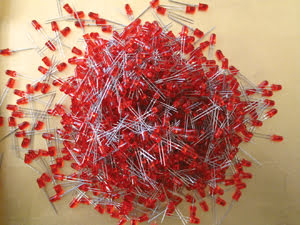The explosive growth of the LED market is well documented, with LED lighting widely reported as being more energy-efficient than other lighting sources as well as more environmentally friendly.
But a new study carried out by teams at the University of California, Davis, and the University of California, Irvine, warns that the increasing use of LEDs could lead to a serious public health issue. The problem occurs when it comes to end-of-lifetime disposal, and public exposure to toxic hazards is set to increase if regulations are not reviewed.
“LEDs have fast become one of the key components of electronics, and they are rapidly becoming ubiquitous, not just in computing and telecommunication tools but in home lighting, automotive equipment, and children’s toys and other novelty gadgets,” said Oladele Ogunseitan, chair of University of California Irvine’s Department of Population Health and Disease Prevention. “So, I think the problem is serious and will continue to grow if we do not nip it in the bud.”

The pin-type red LEDs in the University of California, Davis and University of California, Irvine, study were found to be hazardous according to both US federal and California state regulations. Courtesy of Oladele Ogunseitan, chair of University of California Irvine’s Department of Population Health and Disease Prevention.
Of particular concern are the small indicator or pin-type LEDs used for colored lighting applications such as traffic signals, pedestrian crossings, exit signs and holiday lights; for indoor white-light applications such as task lighting; and for outdoor white lighting such as path illumination.
“The toxicity issue is mainly a concern with the disposal of LED products, but because many domestic LED products are very small, when the products break into components, they pose a risk, especially to little children who may be attracted to the color and size,” Ogunseitan said.
In the study, published in the January 2011 issue of Environmental Science & Technology, Ogunseitan and fellow scientists at University of California Irvine and Davis crunched, leached and measured nine 5-mm pin-type LEDs, purchased from Purdy Electronics Corp. of Sunnyvale, Calif. The process involves drawing out constituent materials under an application acid.
Under scrutiny were red, yellow, green and blue LEDs of low intensity, suitable for single-LED indicator applications, as well as high-intensity versions typically used for outdoor message signboards. Lastly, a high-intensity white LED, suitable for use in LCD backlighting and automobile headlights and brake lights, was also tested.
The report reveals that under US federal regulations, LEDs are not hazardous, except for low-intensity red ones. However, according to California regulations, excessive levels of copper, lead, nickel and silver render all of the tested LEDs hazardous, with the exception of the low-intensity yellow version.
“We think that most of the lead in some LEDs comes from soldering materials, and there is evidence that the lead is released when product integrity is compromised, and in mild acid,” Ogunseitan said. “The acidity of the stomach is stronger than some of the test solutions that we used. We also think that the arsenic is coming from gallium arsenide, used in some LED semiconductor components.”
A spokesperson at Osram Opto Semiconductors points out that the substances referred to in the study are prevalent materials in the electronics industry and that LED components from the company are nonhazardous when handled correctly; they comply with the statutory provisions of the EU governing bans on hazardous substances (RoHS).
“Even in the unlikely event of improper use of LED components, it would not result in a release of hazardous substances in excess of the applicable statutory guidelines,” said the Osram source. “Products containing LEDs are electronic waste and must be disposed of properly in accordance with an EU directive (WEEE).”
Ogunseitan calls for standardization of regulations across different states in the US as well as internationally. But he also believes that manufacturers must do their part, which includes using materials that do not contain arsenic and introducing lead-free soldering.
“I think we should take a comprehensive look at risk throughout the life cycle of LED manufacturing and disposal,” he said. “I am very supportive of the development of LED technology as energy-efficient lighting systems. I just want to make sure that we do not accomplish that at the expense of increasing toxic exposures to the public.”
While Ogunseitan admits that there are no immediate threats to public health from the use of LEDs in lighting, he does stress that there are serious concerns when it comes to the disposal of LEDs and the threat of potentially toxic chemicals leaching into water, soil and the air.
“There are also concerns about consumer understanding of what to do to carefully dispose of products made with LEDs,” he said. “We think that because most people used to throw out their old incandescent lightbulbs in the regular domestic trash when they break or when they burn out, there will be a tendency to do the same for LEDs and compact fluorescent lightbulbs.”